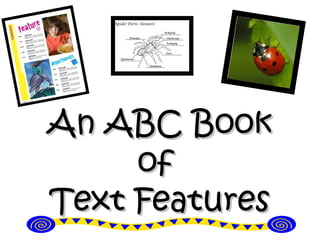Abc Book of Text Features
- 1. An ABC Book of Text Features
- 2. A is for Author Notesabout making the book. A note to readers
- 3. B is for Bold Print-words with thick heavy lines. Brainy Bees Know Two from Three
- 4. C is for Captions-Information that is near a photograph or illustration that it tells. Honeybees have some basic numerical abilities, a new study found. They can recognize a pattern based only on the number of elements in it. For example, if the bees learn to recognize three blue dots, then later they can find three yellow stars, three yellow lemons or three purple blobs.
- 5. D is for Diagrams- is a drawing of something to show its parts. Labels are often added to the diagram.
- 6. E is for Endpages-additional information that supports the book.
- 7. F is for Fonts- The way the typing looks. You will find words in bold and color print in books.
- 8. G is for Glossary-A alphabetized list of special words in a book and their meanings.
- 9. H is for Headings- The title, subtitle, or topic that stands at the top or beginning, as of a paragraph, letter, or chapter.
- 10. Index- I is for An alphabetized list of key information including page numbers. This can be found at the end of a book.
- 11. J is for Just say it! A pronunciation guide is when the writer spells out the words phonetically, often in parentheses. This helps us say the word correctly. "The Gila (HE-la) Monster is a kind of lizard."
- 12. K is for Map Key-Helps the reader know how to interpret information on a map.
- 13. L is for Labels-Helps the reader identify parts of a diagram.
- 14. M is for Map- Helps the reader understand where things are in the world.
- 15. N is for Non-Fiction Text Features ? Helps readers better understand what they are reading about. ? Gives us extra information. ? Text features can be found in textbooks, magazine articles, reports, web pages, and other forms of non-fiction text.
- 16. O is for ClOse Up- Helps the reader see details in something small.
- 17. P is for Photographs-Helps the reader better understand a picture or photograph.
- 18. Q is for Question Format- Questions the author includes in the text for us to think about.
- 19. R is for Reference pages- Helps the reader understand information in the book.
- 20. S is for Sidebars- Boxes of information to the side of the main text/column.
- 21. T is for Table of Contents- Helps the reader identify key topics in the book in the order they are presented.
- 22. U is for Underline- Helps the reader understand that a word or words are important.
- 23. V is for Verso Pages-In page layout, the verso pages are the even-numbered pages on the left side of a two-page spread.
- 24. W is for DraWings- Helps the reader understand what something could have looked liked.
- 25. X is for AppendiX-Additional information located at the end of a book.
- 26. Y is for CutawaY-Helps the reader understand something by looking at it from the inside.
- 27. Z is for ItaliciZed Words- Helps the reader understand that the word italicized is important.



























